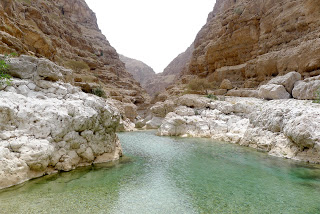
Day Trip to Wadi Shab and its Surroundings
If there is a paradise, I imagine it to look like Wadi Shab. A rocky canyon home to swimming holes that range from aquamarine to emerald, Wadi Shab is simultaneously an undiscovered gem and one of the top things to see in Oman. Wadi Shab’s scenery is breathtaking and certainly worth every penny that we reluctantly relinquished in order to hire our driver and personal guide for the day.
Tour of Wadi Shab and its Surroundings from Sur
The natural highlights of Oman are growing in popularity, they are difficult to visit without a tour or private vehicle. Public transport is virtually nonexistent in Oman. As a result, most tourists visit Oman’s wadis during day tours from Muscat to the Bimmah Sinkhole. There are few (if any) tours that depart fom the city of Sur.
Since we were already in Sur, we decided to hire a driver for the day in order to visit some of the country’s natural highlights. Along the way, we stopped at other Oman attractions, including Wadi Tiwi and the Bimmah Sinkhole.
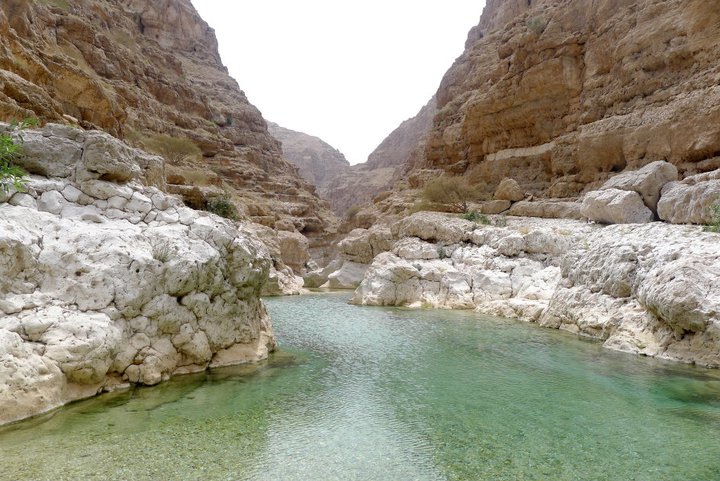
The first stop on our journey was the ancient city of Qalhat—an important location in Omani history that was a stopping point on the journeys of both Marco Polo and Ibn Battuta.
Today, not much remains of the old city, as the majority of it was destroyed in an earthquake. Nonetheless, amid the rubble of crumbling houses that swallow up most of the town, people live ordinary lives and a few old buildings perched atop a surrounding hill remain as a testament to the city’s past.
Our tour of Qalhat was limited to a quick photo from the road before we headed to another coastal village called Tiwi, adjacent to the beautiful Wadi Tiwi.
Wadi Tiwi
Wadi Tiwi is a spectacular diversion from the highway en route to Wadi Shab. Unfortunately, while we were in Wadi Tiwi, a road into the valley was under construction. As a result, slabs of new concrete disrupted the beautiful scenery, while construction noise interrupted the surrounding tranquility.
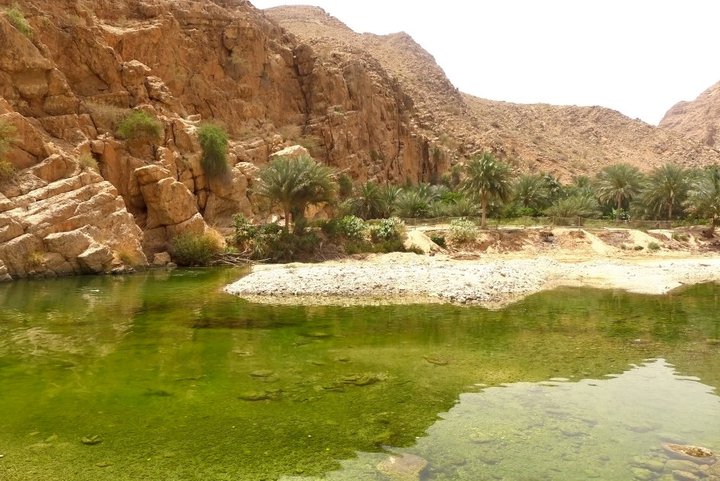
Yet, nonetheless, the area is stunning. The tall cliffs of the wadi overlook deep green pools of water and are dotted with small Bedouin villages. These villages lay on the edge of plantations that are terraced into the rocks.
We wandered up to one of them and sat in the shade of a banana tree as we took in the view. All around us, various types of palms and fruit trees created a green canopy overhead. A small irrigation canal (falaj) gathers water from the wadi and bisects the plantation. It is hard to imagine that this bit of fertile ground lies in the middle of such unforgiving terrain.
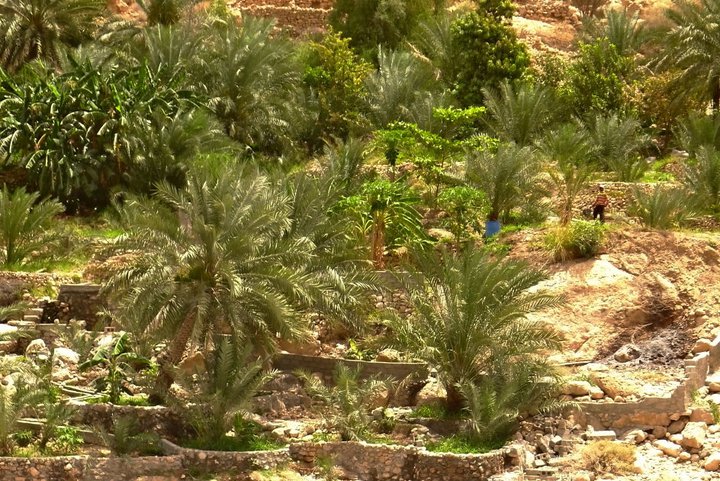
Wadi Shab: Oman’s Turquoise Gem
After a bit of time wandering through the palm-covered plantations of Wadi Tiwi, we proceeded to Wadi Shab, which was undeniably one of the top things to see in Oman. Unlike Wadi Tiwi, there is no road that cuts through Wadi Shab, and the only way to visit the place is by a combination of hiking and swimming.
Turquoise and blue freshwater pools lined with vibrant green palm trees run the length of the valley floor and jagged, copper-colored cliffs create a jaw-dropping backdrop.
The wadi fits into a picture-perfect postcard image that would be drawing flocks of tourists if it were in Europe or North America. Yet, Oman is in the Middle East and, thus, receives much less attention than it deserves. Even for Middle Eastern tourists, it remains a location far off the beaten tourist trail.
As a result, Oman’s dramatic wadis are virtually untouched by international tourism and we were able to explore the place pretty much on our own.
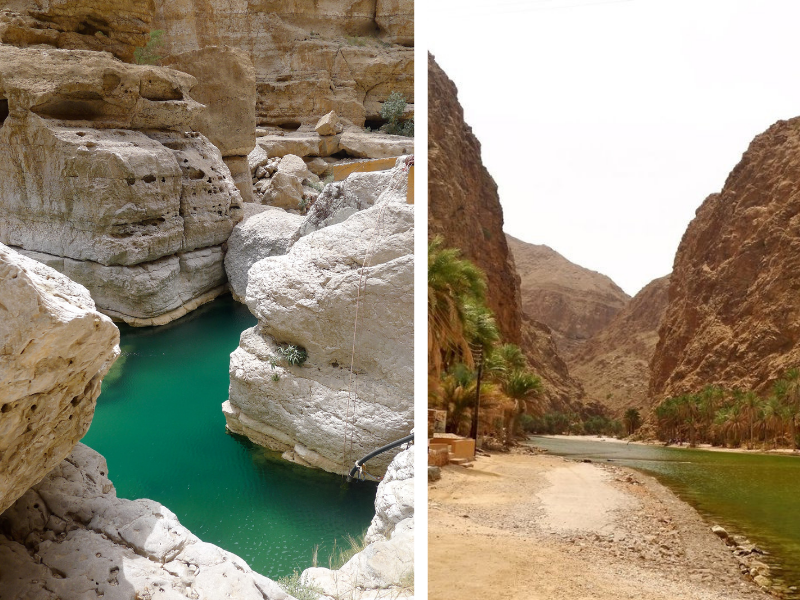
As we followed the pools of water into the canyon, the path ahead became narrower and narrower.
Soon, we were no longer to able to hike alongside the water and the only way to advance was to dispose of our bags and swim the rest of the way. A bit nervously, I hid everything I had brought with me under a bush and began gliding from one pool to another. At one point, when it seemed as though the water could go on no further, our guide pointed out a long, thin crevice in the cliff.
Beyond it, I could see one last pool of water.
Though I am a bit claustrophobic and the idea of weaning my way through a slab of rock that is about as wide as my own body terrified me slightly, what I found on the other side was worth every worry. The passage gave way to a final pool containing a waterfall that was concealed by a cavern of rocks. Light streamed into the semi-open cave and bathed the water in a deep turquoise that was almost fluorescent. It was gorgeous and, for the second time in two days, I wished that I had my camera with
I could have spent days wandering around Wadi Shab and relaxing in the clear pools of water, but we decided to continue on our way and cram in an extra stop before heading back to Sur.
The Bimmah Sinkhole
On our return trip from Wadi Shab to Sur, I remembered reading about the Bimmah Sinkhole on Lonely Planet’s travel forum. Curious as to whether we would be able to add the sinkhole as a stop on our Oman itinerary, I asked our driver about it.
To our delight, he agreed to take us to the Bimmah Sinkhole at no extra cost.
A popular stop on Oman’s budding tourist circuit, the Bimmah Sinkhole is a natural swimming hole that is as beautiful as it is peculiar. The Bimmah sinkhole is a bizarre sight. Another top attraction in Oman, the sinkhole is a circular crater that was created by limestone that collapsed on itself and has since filled with groundwater from the nearby sea.
Local legend has it that a piece of moon collided with Earth to create a hole. The sinkhole is so deep that it is black in some places, though the varying depths create a beautiful palette of colors.
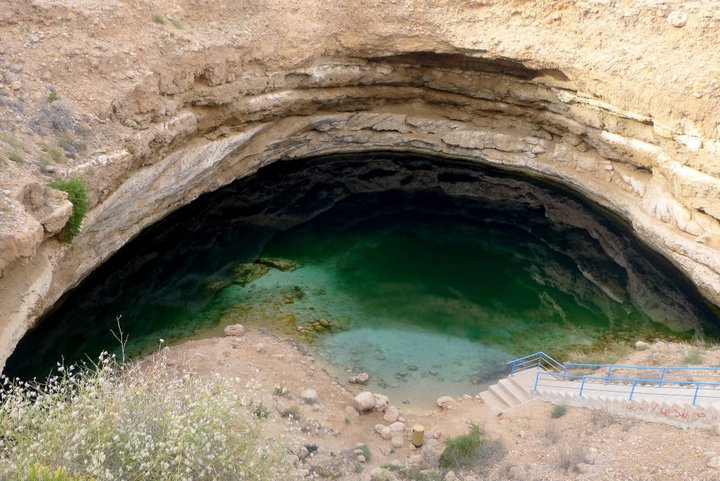
We spent a little bit of time swimming around in the water and my friends and I enjoyed a natural pedicure from the tiny fish that chewed the dead skin on our feet and legs.
The fish in both the wadis and the sinkhole are notorious for feasting on dead skin and I’d been told that Omani women spend a lot of money for this very treatment. They go to beauty salons to literally place their feet in a bucket full of water and fish.
And we were getting this pedicure for free, in a spectacular setting.
It was a relaxing and comical end to a wonderful day.
***
Though Oman’s nascent tourism industry has grown by leaps and bounds since my visit in 2012, the country is still an undiscovered and under-visited gem. Partially thanks to its location in a politically volatile region, Oman isn’t popular with the masses. Yet with spectacular natural attractions like Wadi Shab, Wadi Tiwi and the Bimmah Sinkhole, I don’t expect this stable and prosperous Middle Eastern country to remain a secret for long.
Additional Tips and Resources for Visiting Oman
- Check out Dan’s list of 10 reason’s to visit Oman, for more information on visiting the country.

